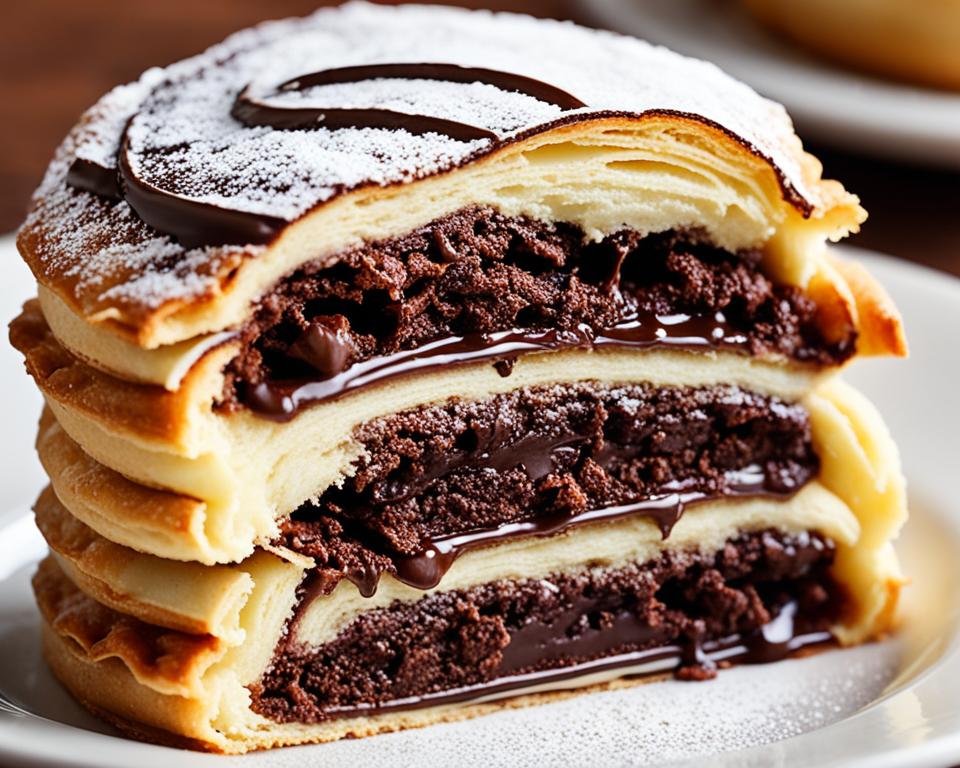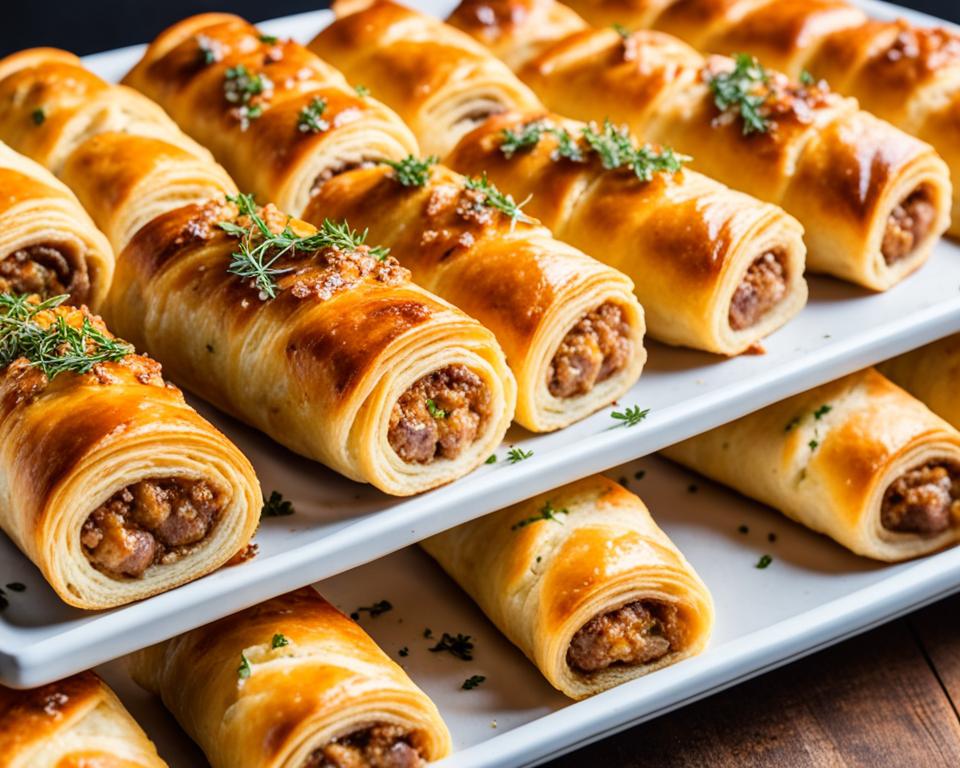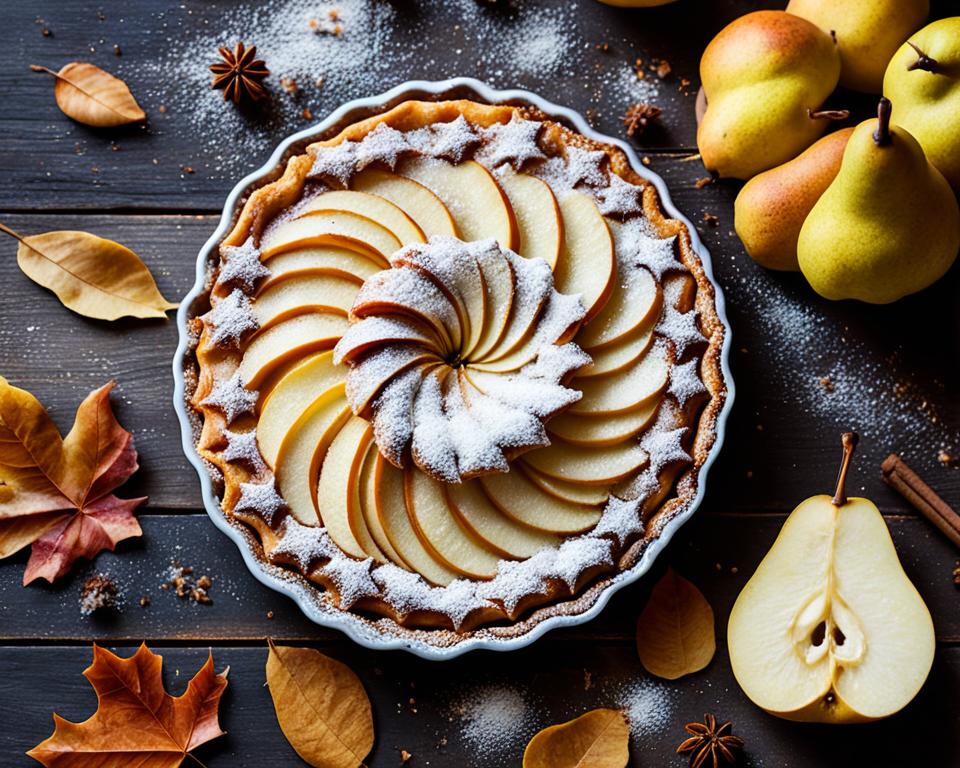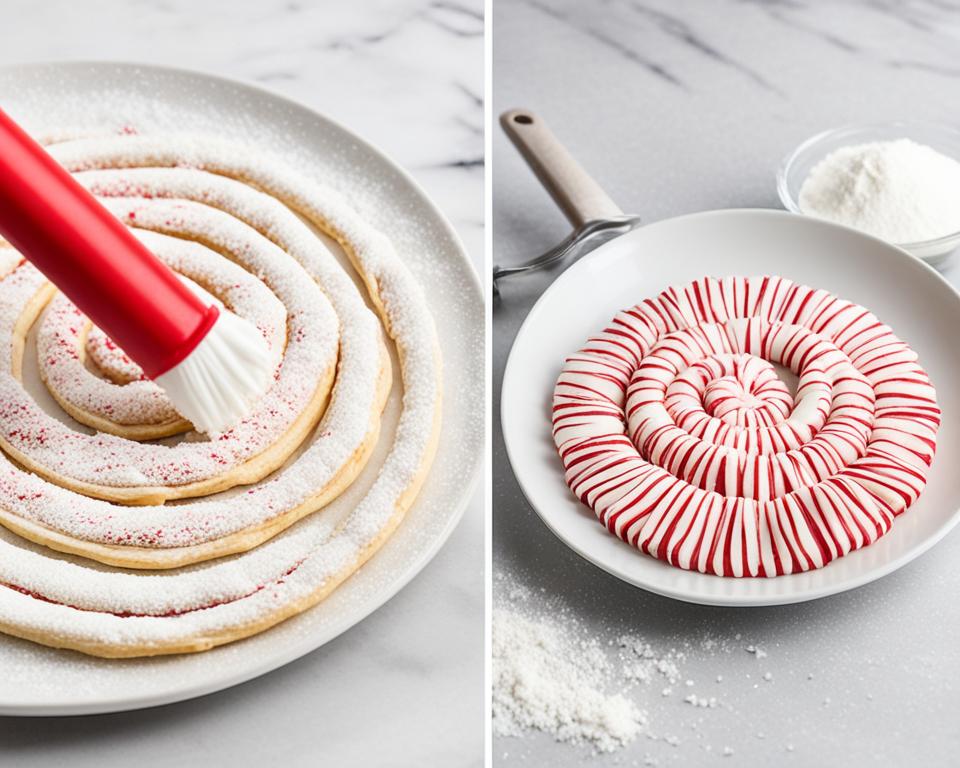Imagine awakening to a delicious breakfast indulgence, the scent of buttery perfection intertwined with rich chocolate, emanating from your very own kitchen. This is the allure of baking Flaky Pain au Chocolat at home—a gourmet treat that transforms a morning routine into a French culinary escapade. With this detailed chocolate croissant recipe, enthusiasts can replicate the intricate textures and sublime flavors of a quintessential French pastry. The magic begins with high-grade chocolate batons, such as those from Cacao Barry Extruded Bâtons Boulangers, promising a melt and distribution that’s nothing short of perfection encapsulated within a homemade buttery layer.
The journey into authentic French baking awaits, guided by precision in technique and reverence for classic indulgence. There’s no better time than now to don your apron, ready your rolling pin, and transport your senses to the streets of Paris with every bite of Pain au Chocolat, fresh from the oven.
Key Takeaways
- True Flaky Pain au Chocolat at home is achievable with the right chocolate and technique.
- Selecting chocolate batons over chips ensures even melting and distribution.
- A successful homemade French pastry is a blend of skill and high-quality ingredients.
- The buttery and flaky texture of Pain au Chocolat begins with an all-butter croissant dough.
- Staying true to the methods of French bakers is key to a delightful chocolate croissant experience.
- Savoring your homemade pastries warm is the epitome of a delicious breakfast indulgence.
The Art of Authentic French Baking
Delving into the world of Authentic French baking elicits images of quaint Parisian cafes and the irresistible aroma of fresh bread and flaky pastries. The mastery of such culinary delights, including the beloved Pain au Chocolat, is an intricate art form steeped in tradition and precision. Key to realizing these culinary treasures is the foundational understanding of French pastry techniques, the selection of fine ingredients, and the patience to execute these time-honored methods meticulously.
True enthusiasts of French patisserie recognize that creating the perfect French pastry is more than just following a recipe—it’s a form of expression, a meditative practice, and above all, a testament to one’s dedication to the craft. With each layer of buttery dough and each carefully placed piece of chocolate, bakers weave a story of culture, technique, and flavor that culminates in the ultimate delicious breakfast pastry. Allow us to guide you through the nuances of creating Pain au Chocolat that echo the essence of France’s revered boulangeries.
Understanding the Basics of French Pastry
Embarking on the journey to bake chocolate-filled pastries begins with appreciating the basics. From weighing every gram of flour to meticulously measuring the temperature of the dough, every step is pivotal in the pursuit of perfection. The delicate balance of ingredients, the precise control of the environment, and the skilled manipulation of dough work in harmony to create pastries that are both luxurious and invitingly rustic.
Why Pain au Chocolat is a Gourmet Breakfast Treat
In the realm of sweet indulgences, Pain au Chocolat stands as a sovereign selection. This crown jewel of French pastries, embodying the opulence of chocolate encased in layers of feather-light dough, elevates a humble breakfast to a grand experience. Popular across the globe, its reputation as a gourmet breakfast treat is unrivaled, promising a taste of France with every bite. Whether it’s enjoyed in the soft morning light or savored as an afternoon delight, Pain au Chocolat offers a world of flavor waiting to be explored.
In baking, as in all things, quality begets quality. In every Pain au Chocolat, you taste not just the chocolate or the dough, but the history, care, and passion that have been folded into its creation.
Choosing the Right Ingredients for Flaky Pain au Chocolat
Selecting the ideal ingredients is crucial when attempting to emulate the allure of authentic French baking. This journey begins with the undeniable heart of the pastry — the chocolate. Indeed, opting for high-quality chocolate batons is not merely a preference but a necessity for creating that quintessential melt and rich taste. Brands like Cacao Barry are revered in professional baking circles for this exact reason.
Of equal importance is the infamous butter pastry. Here, it’s the rich, decadent butter that infuses each bite with its signature mouthfeel. The market offers a variety of options, yet for that unparalleled flakiness in your Pain au Chocolat, European-style butter with a higher fat content is the artisan’s choice. The characteristics of this butter contribute not only to flavor but also to the delicate, layered dough structure that gourmands desire.
Each layer of Pain au Chocolat whispers a story of tradition and craftsmanship, a delicious narrative held together by choice ingredients.
- Premium butter is the cornerstone of a flaky texture
- Quality chocolate batons distribute evenly for a rich filling
- Choice of ingredients speaks volumes of the final pastry’s character
To contextualize the significance of these choices, a comparison of standard baking chocolate versus high-end chocolate batons is presented in the table below:
| Ingredient Quality | Flavor Profile | Texture Contribution | Melting Behavior |
|---|---|---|---|
| Standard Baking Chocolate | Milder Chocolate Taste | Irregular Texture | Unpredictable Melting |
| High-Quality Chocolate Batons | Rich and Complex | Smooth and Consistent | Even and Perfect Melt |
Understanding that the essence of Flaky Pain au Chocolat is intrinsically linked to the quality of butter and chocolate, it becomes clear why these essential components must be chosen with care. Armed with these insights and the right ingredients, you stand on the cusp of creating an indulgent, chocolate-filled pastry reminiscent of a Parisian morning.
Creating the Perfect Laminated Dough
The journey to crafting the beloved Pain au Chocolat hinges upon the creation of flawless laminated dough for croissants. This precise blend of flour, water, and butter forms the heart of various butter pastries, and when done right, results in a product that’s not only visually stunning but packed with delicate layers of flavor and texture.
Dough Lamination: The Secret to Flakiness
Achieving the celebrated flaky texture of Pain au Chocolat starts with the dough lamination process. It’s a meticulous technique where butter is folded into the dough multiple times, creating thin layers that give the pastry its distinctive lightness and flakiness post-baking. This labor of love requires patience and precision, as each fold and roll brings the pastry one step closer to perfection.
Keeping the Dough Cold: Tips and Techniques
To produce an authentic Flaky Pain au Chocolat, maintaining a cool dough temperature is crucial. Keeping the dough cold ensures that the butter stays solid, which is necessary for forming those coveted layers during the lamination process. Techniques such as resting the dough in the refrigerator between folds and working in a cool environment help preserve the integrity of the butter, preventing it from melting into the dough.
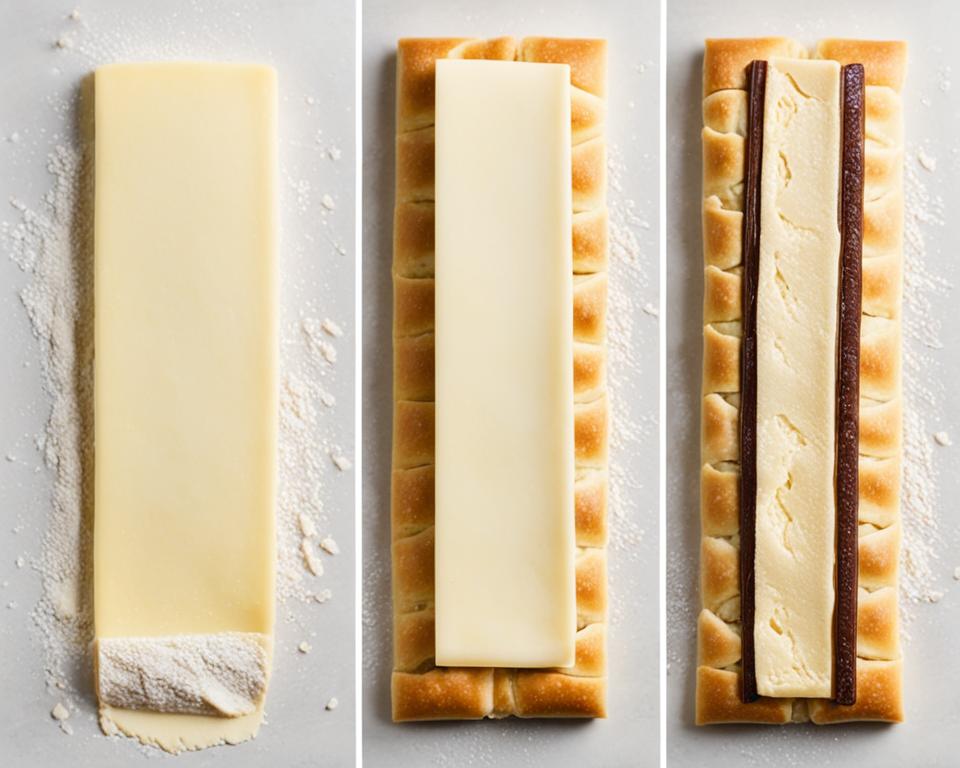
The table below outlines some practical tips for managing dough temperature throughout the baking process:
| Stage | Tips for Temperature Control | Outcome |
|---|---|---|
| Pre-lamination | Chill the butter until it is firm but pliable, ideal for layering without melting. | The dough remains manageable and butter integrates well without leaking. |
| During lamination | Roll out dough on a cold surface; return to refrigerator between folds. | The dough maintains its cool temperature, preserving the layers of butter. |
| Post-lamination | Refrigerate the laminated dough before shaping and cutting. | Dough is easier to shape and less prone to sticking, ensuring cleaner cuts. |
| Before baking | Place shaped pastries in the fridge to firm up if room temperature rises. | Ensures the pastry retains its shape and texture while exposed to oven heat. |
With these guidelines in mind, ensuring that the laminated dough remains cold is not an insurmountable task. Instead, it’s a key aspect of the process that brings a homemade Pain au Chocolat from good to extraordinary — resulting in a butter pastry that balances intricate, airy layers with a sumptuous bite.
Mastering the Butter Layer for Layered Dough
The Flaky Pain au Chocolat, a hallmark of authentic French baking, captivates with its delicate, buttery layers. Achieving such finesse begins with a meticulous butter layer, known to be the foundation of the pastry’s layered dough. This process entails harmoniously blending lard and butter, followed by strategically rolling out the compound between sheets of film to create a thin, even layer.
Once solidified to an optimal hardness in the refrigerator, the butter layer is skillfully worked into the dough. This crucial step is pivotal to the lamination process, influencing the final product’s flaky texture. This technique embodies the essence of a delicious breakfast pastry, ensuring the authentic Flaky Pain au Chocolat‘s structural integrity and culinary excellence.
By giving due reverence to the art of the butter layer, bakers weave flavor and texture into every fold, promising a taste experience akin to the patisseries of France.
- The successful integration of butter and lard yields a butter layer essential for flaky textures.
- Chilled but malleable, the consistency of the butter layer is crucial when folding into the dough.
- Lamination steered by this process is the cornerstone of creating the quintessential French pastry.
- As the butter melts during baking, it steams through the dough, resulting in the Pain au Chocolat’s layered, airy expanse.
Mastery of the butter layer is but the prelude to the symphony of layers that form the layered dough. Only through this precision and care can the Flaky Pain au Chocolat rise with distinction, ready to be a centerpiece at the breakfast table.
Rolling and Folding: Achieving Layers of Flakiness
Transforming a simple piece of dough into a sublime Pain au Chocolat is an art that hinges on the rolling and folding technique. With patience and precision, the baker can create a pastry with a flaky texture that epitomizes French pastry excellence. The dough’s journey from elasticity to delicacy is a testament to the craft of authentic French baking.
The Technique of Rolling Out Your Dough
The initial step is rolling out dough to the right thickness, which sets the stage for the flakiness of the Pain au Chocolat. This requires extending the dough into a precise rectangle, a size that’s optimal for encasing the all-important butter sheet. The chilled butter is then placed atop the expanse of dough, initiating the lamination process that is so crucial to achieving the desired flaky layers.
Folding for Texture: A Step-by-Step Guide
After the dough is rolled out, the fusion of flour and fat begins with the folding. This technique, which requires dexterity and accuracy, involves enveloping the butter inside the dough’s embrace. The whole parcel is then folded, forming a booklet of sorts, which is a layered prelude to what will eventually unfold as flaky, ethereal bites of Pain au Chocolat.
- First fold: envelop the butter sheet with the dough, sealing it within.
- Resting: place the dough in the refrigerator to cool, ensuring the butter’s solidity is preserved.
- Second and subsequent folds: continue to roll out and fold the dough, repeating the process to compound the layers.
- Final chilling: a rest in the cold before the next step ensures optimal handling and keeps the flaky structure intact.
Persistence in this process fortifies the dough, bestowing upon it the characteristics that will render it both flaky and tender. Each fold introduces a new layer, each chill solidifies the formation, and in this repetition lies the secret to the classic French pastry’s flaky texture.
| Fold | Action | Chilling Time |
|---|---|---|
| First | Encase the butter in dough | 30 minutes |
| Second | Roll and fold into thirds | 30 minutes |
| Third | Turn dough 90 degrees, roll, and fold | 30 minutes |
| Final | Shape and prepare for chocolate placement | Overnight |
At the heart of the flaky texture of this Pain au Chocolat lies the dedication to the methodical folding and careful temperature control. When adhered to with care, this folding technique pays off with each buttery, flaky layer that delights the senses, confirming that indeed, good things come to those who bake.
Chocolate Selection: Using the Best Chocolate for Fillings
At the heart of every gourmet breakfast treat lies the promise of indulgence and satisfaction. When it comes to chocolate-filled pastries, the choice of chocolate is not just a detail—it is paramount to achieving a balance of flavor and texture. In the pursuit of crafting an authentic Pain au Chocolat, one must be fastidious in their chocolate selection.
For lovers of supreme chocolate-filled pastries, the difference between ordinary and exceptional lies in the use of chocolate batons. Unlike the more commonly available chocolate chips or chunks, these specially designed batons are made to integrate with the pastry seamlessly, providing an even distribution that results in a uniform melt throughout. The superiority of these chocolate batons is evident in every bite, as they combine with the flaky layers of dough to epitomize what a gourmet breakfast treat should be.
| Chocolate Type | Reason for Selection | Impact on Pastry Quality |
|---|---|---|
| Chocolate Batons | Even melt, uniform distribution | Consistent chocolate in every layer, enhances gourmet experience |
| Standard Chocolate Bars | Readily available, varied sizes | Possibility of uneven chocolate pieces affecting texture |
| Chocolate Chips | Convenience, pre-sized | May not melt uniformly, can disrupt laminated pastry structure |
The culinary quest for the perfect chocolate selection leads to a unanimous conclusion among experts and enthusiasts alike: investing in top-tier chocolate batons is a non-negotiable step towards the creation of premium chocolate-filled pastries. Whether served at a bustling cafe or enjoyed in the comfort of home, a Pain au Chocolat made with high-quality chocolate batons rises to the occasion, solidifying its status as the quintessential gourmet breakfast treat.
Every chocolatier’s aspiration is to complement the rich butteriness of pastries with the depth and harmony of fine chocolate—an aspiration met with the judicious selection of chocolate batons for an unparalleled Pain au Chocolat.
Assembling Your Chocolate-Filled Pastries
The art of crafting chocolate-filled pastries such as Pain au Chocolat requires more than just mixing and kneading; the assembly of these treats is where the true finesse of a baker shines. Assembling pastries with care ensures that each bite delivers the anticipated chocolatey delight. To achieve perfection in every piece, it’s paramount to follow key steps that ensure an even distribution of chocolate and prevent chocolate leakage.
Placing Chocolate Batons for Even Distribution
The strategic placement of chocolate batons within the dough is the first critical step in assembling your pastries. Focusing on even distribution of chocolate is essential. It determines not only the consistency of each bite but also the overall aesthetic appeal once baked. Lay out your pre-cut dough, and meticulously place the chocolate baton slightly off-center, ensuring there’s ample room to seal the dough without the chocolate pressing against the seams.
Sealing Your Pastries: Preventing Chocolate Leakage
Once the chocolate batons are in place, the next task at hand is to expertly wrap and seal the dough to form the recognizable shape of Pain au Chocolat. A carefully sealed pastry is key in preventing chocolate leakage during the baking process. You’ll need to fold the dough over the chocolate, apply gentle yet firm pressure on the seams, and ensure that the final edge is neatly tucked underneath, keeping the chocolate snugly within its buttery cocoon.
| Step | Instructions | Tips for Success |
|---|---|---|
| Cutting the Dough | Cut into rectangles sized for individual pastries. | Use a sharp knife for clean edges to facilitate proper sealing. |
| Placing Chocolate | Position chocolate batons adequately on the dough. | Ensure the chocolate is not touching the edges to prevent leakage. |
| Sealing Edges | Fold and press the edges to encase the chocolate. | Leave no gaps to avoid chocolate oozing out during baking. |
| Final Preparation | Tuck the final edge beneath the pastry. | Creates a seamless underside, securing the chocolate within. |
When executed correctly, these techniques result in an impeccable Pain au Chocolat, each with a uniform look and rich, molten chocolate interior upon the first taste. The balance between a flaky exterior and a warm, soft chocolate center is achieved through precise assembly—a cornerstone in the creation of the iconic French pastry that tempts and satisfies with each bite.
Proofing and Baking: The Key Steps to Delicious Breakfast Pastry
The transformative stages of proofing pastries and baking French pastry are, without a doubt, the lynchpins in achieving an unforgettable Flaky Pain au Chocolat. The prowess exhibited during these steps can mean the difference between a merely decent pastry and a delicious breakfast pastry that transports your senses straight to a sun-kissed café in France. Proofing, the delicate art of allowing the dough to rise, is meticulously attended to in a well-honed environment, while baking crystallizes the culmination of this craftsmanship into a golden-brown marvel.
Proofing requires an ambient warmth where the leavening agents within the dough can work their magic. A common trick among bakers to create such an environment involves placing the pain au chocolat in an oven that’s not turned on, coupled with a bowl of hot water to bring about the warmth needed. Here, the pieces of dough double in size, their gluten structures strengthening and yeast fermenting, paving the way for a lofty Pain au Chocolat. After proofing, the pastries are primed for the oven, where the application of heat will create that sought-after flakiness with a crisp outer shell.
| Process | Description | Key Considerations |
|---|---|---|
| Proofing | Rising of the dough in a controlled, warm environment. | Temperature must be warm enough to encourage rising but not so hot as to start the baking process. |
| Baking | Applying heat to cook the pastries until golden brown. | Even heat distribution is essential for consistent coloring and texture. |
| Cooling | Allowing pastries to rest and structure to set post-baking. | Pastry should be cooled on a rack to prevent sogginess from trapped steam. |
Achieving a delicious breakfast pastry akin to the lauded Flaky Pain au Chocolat comes down to the baker’s ability to weave together the subtleties of yeast fermentation and the robustness of the oven’s heat. Each phase is critical, each temperature pivotal, and each moment in the oven calculated, to render a pastry that’s not just a treat but a testament to the art of baking French pastry. As these delightful pastries exit the oven, their flaky layers and rich chocolate fill offer a tantalizing peek into the heart of French baking decadence.
Getting the Flaky Texture Right: Baking Temperature and Time
To achieve the exquisitely flaky texture that a chocolate croissant is renowned for, understanding the nuances of baking temperature and timing is key. These two components are the architects of texture, dictating the transformation of dough into a gourmet treat. Their precise management is what separates the novice from the virtuoso in the realm of authentic French baking.
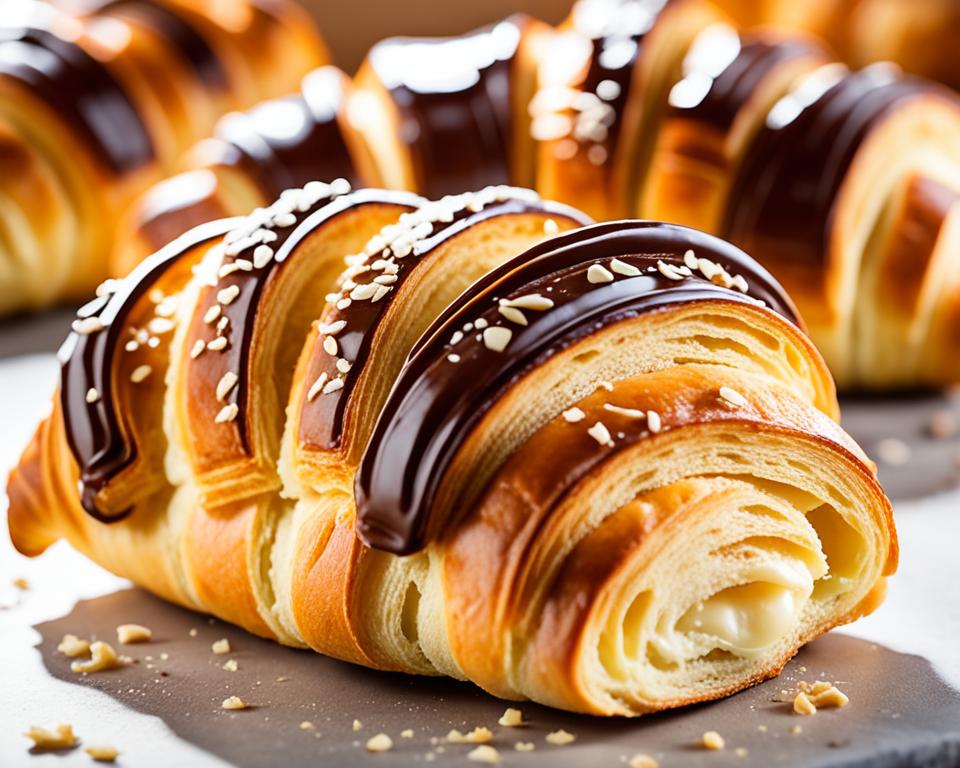
Why Oven Temperature Matters for Flakiness
The architect of a perfect Pain au Chocolat lies not just in the ingredients but also in the control of the baking environment. The initial introduction to a hot oven followed by a prompt reduction in temperature ensures that the layers of butter trapped within the dough melt slowly, creating steam. This process elevates the dough to create that distinct, layered flaky texture that is both visually appealing and indulgent in taste.
Timing is Everything: Baking Your Pain au Chocolat to Perfection
While temperature sets the stage, timing plays the starring role in the baking process. The length of time your chocolate croissant spends in the oven will determine whether it achieves the coveted balance between crisp exterior and tender, airy interior. Monitoring the transformation closely, adjusting as needed, and trusting the process, will bring forth a gourmet treat emblematic of authentic French baking.
| Step | Action | Impact on Pain au Chocolat |
|---|---|---|
| Oven Preheating | Start at high temperature(425°F) | Fosters initial rise and layer separation |
| Temperature Reduction | Decrease to 375°F after placing pastry in oven | Ensures thorough baking without overbrowning |
| Baking Duration | 18 to 24 minutes until golden brown | Results in a golden, crispy, flaky texture |
By adhering to these guidelines, your rise to becoming an adept in crafting chocolate croissants is all but assured. The outcome? A sublime, flaky texture that is both rewarding in creation and delightful in consumption—a true staple of authentic French baking and a gourmet treat par excellence.
Pain au Chocolat Finishing Touches for Maximum Enjoyment
The journey of creating the perfect Flaky Pain au Chocolat is almost complete as one approaches the all-important finale: the finishing touches. These are not mere afterthoughts but, instead, integral steps that infuse charisma and depth into the classic chocolate croissant. A tender blend of beaten egg and milk, brushed gently atop each pastry, bestows a lustrous sheen and a tempting golden hue reflective of authentic French baking expertise.
Once out of the oven, while still warm and fragrant, the pastries are ready for their final adornment. The glaze acts not just as a visual enhancer but melds with the flaky crust to create a subtle layer that accentuates the rich chocolate nestled within. These crowning gestures ensure that every bite, from the crisp exterior to the velvety chocolate core, is an affirmation of quality and craft.
Nothing rivals the pleasure of a Pain au Chocolat that encapsulates both the beauty and the essence of a Parisian patisserie—this is the promise fulfilled by the deft touch of a final glaze.
- Glistening appearance from an egg-milk glaze
- Additional layer of richness in flavor
- Enhanced aesthetic appeal
- A sensorial celebration of authentic French baking
The distinction in enjoying a delicious breakfast pastry lies in its details, its homemade authenticity, and the care woven into every layer. Applying these finishing touches may appear simple, but they require a baker’s intuition and a spirit of craftsmanship. By honoring these final steps, one ensures that each Flaky Pain au Chocolat is a masterpiece of art and taste, ready to be savored as an exquisite chocolate croissant in all its glory.
Serving and Pairing Your Pain au Chocolat
The moment you’ve crafted the perfect Flaky Pain au Chocolat, thoughts naturally turn to the best ways of Serving Pain au Chocolat and selecting accompaniments that enhance the experience. Whether sharing with friends or indulging solo, the pairing of this delicious breakfast pastry with the right beverage can elevate your enjoyment to new culinary heights.
The Best Beverages to Complement Your Pastry
The power of a thoughtful beverage pairing cannot be understated when it comes to French pastries. The right drink can bring out the subtleties in a French pastry and intensify the pleasure of each bite. For instance, a dark, robust espresso contrasts wonderfully with the buttery richness of the Pain au Chocolat, cutting through the sweetness to create a balanced symphony of flavors.
- Robust Espresso – To contrast the buttery sweetness
- Velvety Hot Chocolate – For a double chocolate indulgence
- Light and Fragrant Tea – To complement without overwhelming
How to Serve Pain au Chocolat: Warm or Room Temperature?
The allure of a Pain au Chocolat is its versatility in serving options. When served warm, the chocolate center oozes into the flaky layers of the pastry, creating an irresistible, sensory-rich experience. However, allowing the pastry to come to room temperature can enhance the crispiness of its exterior, offering a delightful textural contrast. Your choice may hinge on the moment, the setting, or simply personal preference.
| Temperature | Characteristics | Best Time to Enjoy |
|---|---|---|
| Warm | Oozing chocolate, soft pastry | Directly from the oven, for immediate indulgence |
| Room Temperature | Enhanced crispiness, firm chocolate | Any leisurely moment, when time allows flavors to settle |
Whether choosing to savor your Pain au Chocolat with a steaming cup of espresso or enjoying it leisurely at room temperature with a delicate tea, you count on a taste experience that’s richly rewarding. This classic French pastry, a highlight of any delicious breakfast pastry spread, continues to be a testament to the timeless art of pastry making and the simple pleasure of pairing pastries with just the right touch.
Pain au Chocolat Variations and Tips for Home Bakers
Delving into the world of homemade French pastries, home bakers are often eager to explore various Pain au Chocolat variations to cater to different dietary needs and preferences. With the increasing popularity of plant-based diets, many are seeking vegan chocolate croissants and dairy-free Pain au Chocolat. The beauty of these pastries is that their rich, flaky goodness can be achieved without compromising on ethical or dietary standards. To guide you on this sweet journey, consider these home baking tips and alternative approaches to meet your vegan and dairy-free baking aspirations.
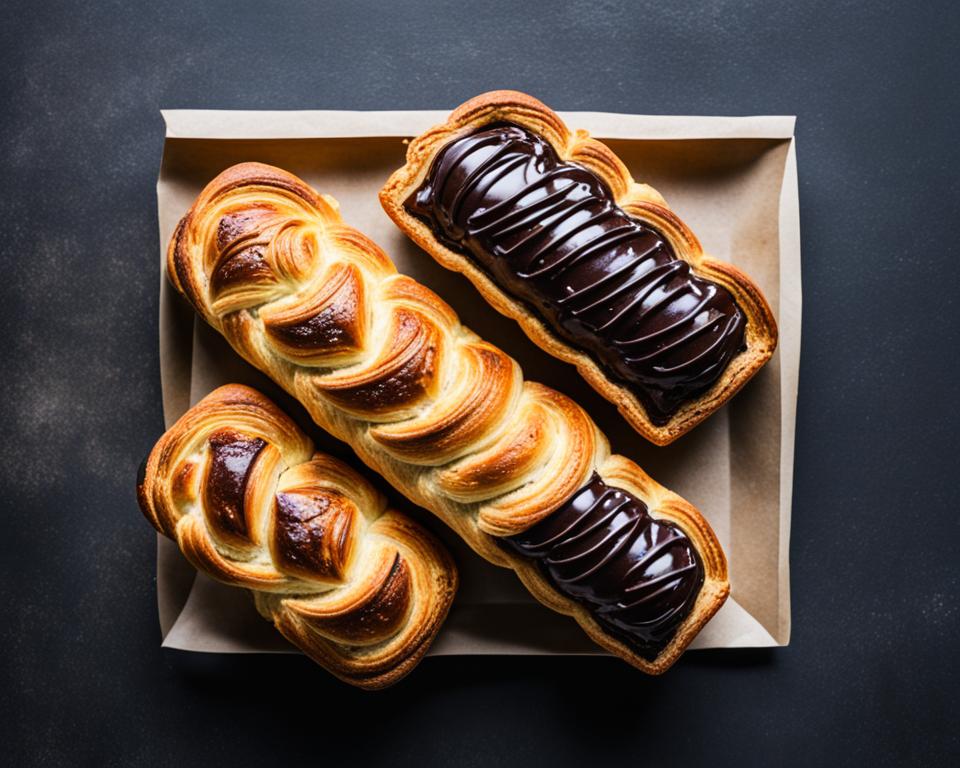
Vegan and Dairy-Free Versions
For those who follow a plant-based diet or have dairy sensitivities, traditional butter and eggs can be replaced with quality substitutes without sacrificing flavor or texture. Brands like Earth Balance offer vegan butter sticks that function similarly to dairy butter in pastry recipes, ensuring that dedicated vegans can enjoy vegan chocolate croissants that rival the taste and texture of their classic counterparts. Similarly, ingredients like flaxseed meal or commercial egg replacers provide a binding element in lieu of eggs. Here are a few tips to ensure success:
- Choose high-fat content vegan butter for a rich, flaky texture.
- Opt for unsweetened plant-based milk instead of dairy milk for the dough and glazing.
- Utilize quality dark chocolate that’s dairy-free to maintain the indulgence of the chocolate filling.
Troubleshooting Common Baking Issues
In the process of home baking, hurdles such as butter leakage or under-proofed dough can arise, but fear not, as these are common and treatable dilemmas. Prevention is always preferable, and here’s how:
- Ensure that your dough and butter are both properly chilled before beginning the lamination process to prevent the butter from melting prematurely.
- Be patient with proofing; dough that has doubled in size typically showcases that yeast has properly fermented, ensuring a light and airy finish.
- Apply firm pressure when sealing dough edges around the chocolate to discourage leakage during baking. A well-sealed edge is your best defense.
Remember, perfecting the art of Pain au Chocolat requires practice, and each baking adventure is an opportunity to refine your craft. Whether aiming for traditional richness or exploring alternative options like vegan chocolate croissants, the path to a glorious, flaky pastry is at your fingertips, with resources and home baking tips readily available to guide you in every impressive roll and fold.
Storing and Reheating: Keeping Your French Pastry Fresh
The love affair with a French pastry doesn’t end once it leaves the oven. Even the most exquisite Pain au Chocolat, that quintessential gourmet breakfast treat, has a fleeting moment of perfection. To enjoy this bliss beyond the bake, one must master the art of storing pastries to maintain their French pastry freshness. The key is to guard the flaky splendor of each croissant against the ravages of time and air.
When there are leftovers to be savored later, swift and proper storage is essential. An airtight container becomes the armor that shields the pastries from staleness, moisture, and other flavor marauders. Refrigeration can seem like a safe haven, but it’s truly the antithesis of freshness for your Pain au Chocolat, potentially turning it dense and doughy. Instead, room temperature is often your ally in the quest to prolong life.
For those who plan their indulgence with foresight, freezing stands as the noble protector of the pastry’s integrity. Once the Pain au Chocolat has cooled completely, snugly wrapping them in freezer bags is akin to placing them in a cryogenic chamber, halting the march of time. Thawing is a delicate resurrection, a gentle return to room temperature that anticipates the crowning glory of reheating.
With the magic of a warm oven, reheating Pain au Chocolat can channel that ephemeral boulangerie allure into your home once more. A gentle heating at 300°F (150°C) wraps the pastries in a soothing hug, tickling them back to life. The once sleepy chocolate reawakens, the pastry’s layers separate once again into their distinctive flakiness, and the familiar aroma heralds a revival of the gourmet experience.
Knowing how to properly store and reheat Pain au Chocolat empowers you to extend the joy of French patisserie, making any moment ripe for a celebratory treat.
- Store leftover pastries in an airtight container at room temperature to keep them fresh.
- Freeze Pain au Chocolat by wrapping them individually in freezer bags to halt the aging process.
- Revive the freshness by reheating in a preheated 300°F oven until they are warmed through.
Follow these steadfast tips, and storied French pastry treasures will never lose their luster. Whether for a sophisticated soiree or a simple solitary coffee break, your Pain au Chocolat will stand the test of time, always ready to serve as a gourmet breakfast treat or a luxurious snack.
Conclusion
Embarking on the journey of creating the perfect Flaky Pain au Chocolat is an ode to the discipline and richness of authentic French baking. It is a commitment that evolves into a delectably rewarding experience. The selection of top-quality ingredients, mastery over lamination, and precise baking techniques contribute to the craftsmanship of a truly delicious breakfast pastry. Indeed, the fruition of this culinary endeavor lies not just in the buttery layers but also in the gourmet treat that awaits your senses with each bite.
With every fold of dough and every sprinkle of chocolate, the homage to French Patisserie becomes more evident. The personal touch in home baking elevates a simple act to the realms of creating a timeless French pastry. Whether for a special occasion or a personal indulgence, the ritual of baking from scratch is a testament to the enduring allure of French culinary artistry. As you savor each flaky, chocolate piece, you connect with a tradition that spans generations and continents, underscoring the universal language of good food crafted at home.
Let every batch of Pain au Chocolat that emerges from your oven be a celebration of fine taste and a heartfelt tribute to the French baking legacy. Embrace the pride in crafting and sharing such a gourmet treat, the warmth of which lingers far beyond the last morsel. Your endeavors in the kitchen mirror the essence of passion and patience, proving that with each layer of this delicious breakfast pastry, you unfold not just a Pain au Chocolat but a slice of joyous culinary culture.
FAQ
What is Flaky Pain au Chocolat?
Flaky Pain au Chocolat is a French pastry known as a chocolate croissant in English. It’s a buttery, layered dough with a delicious chocolate filling, often enjoyed as a gourmet breakfast indulgence.
Why is Pain au Chocolat considered a gourmet treat?
Pain au Chocolat is considered a gourmet treat because it’s made with high-quality ingredients and involves a detailed baking process that’s characteristic of authentic French baking. The delicious breakfast pastry is both decadent and satisfying.
What type of chocolate should be used in Pain au Chocolat?
High-quality chocolate batons are recommended for Pain au Chocolat. They provide even distribution of chocolate within the pastry and melt perfectly to complement the flaky, buttery dough.
What is laminated dough and why is it important for Pain au Chocolat?
Laminated dough is the technique used to create layers of dough and butter, which are folded and rolled multiple times to achieve a light, airy, and flaky texture. This is crucial for authentic Pain au Chocolat, which is prized for its flaky layers.
How do you keep the dough cold when making Pain au Chocolat?
To keep the dough cold, it is important to work quickly and handle the dough as little as possible. The dough should be refrigerated between folding steps to maintain a low temperature, preventing the butter from melting and ensuring successful lamination.
What is the key to achieving the perfect butter layer in layered dough?
The key to achieving the perfect butter layer in layered dough is to ensure the butter is at the correct temperature — cool enough to be malleable yet firm enough to create distinct layers within the pastry.
Can you explain the rolling and folding technique for Pain au Chocolat?
Rolling and folding involve spreading the dough into a rectangle and placing a sheet of chilled butter on top, followed by folding the dough in a way that encases the butter. This technique is repeated several times, resting the dough in the refrigerator between folds to build the pastry’s flaky layers.
How are chocolate batons placed in the dough for Pain au Chocolat?
Chocolate batons are strategically placed on top of the rolled-out dough before it’s folded and rolled to encase them. This placement ensures they are evenly distributed throughout the pastry, resulting in a perfected chocolate-filled pastry after baking.
How can I prevent chocolate leakage when making Pain au Chocolat?
To prevent chocolate leakage when making Pain au Chocolat, ensure the dough is properly sealed around the chocolate batons, and avoid overfilling. It’s also crucial to not let the pastries get too warm before baking, which could cause the butter to melt and lead to leakage.
What are the proofing and baking requirements for the perfect Pain au Chocolat?
Proofing should be done in a warm, draft-free area until the pastries have doubled in size. Baking requires precise temperature control: starting in a hot oven and then lowering the temperature to create the perfect baking conditions for a golden, flaky Pain au Chocolat.
How does oven temperature affect the flakiness of Pain au Chocolat?
Oven temperature is crucial to achieving the flakiness of Pain au Chocolat. A higher initial temperature helps the dough to rise and create layers, while a lower temperature ensures the pastry cooks through without burning, resulting in a flaky texture with a crispy, golden exterior.
Why are timing and temperature crucial when baking Pain au Chocolat?
Timing and temperature are vital to ensure that the Pain au Chocolat is baked to perfection. The correct timing ensures that the pastry is cooked just right and that the butter creates steam within the dough to form the flaky layers, while the right temperature guarantees a golden crust.
What are the ideal pairings for Pain au Chocolat?
Pain au Chocolat pairs wonderfully with hot beverages such as coffee, tea, or hot chocolate. The drink’s warmth complements the pastry’s butteriness and chocolate flavor, enhancing the overall taste experience.
How should Pain au Chocolat be served?
Pain au Chocolat can be served warm from the oven, when the chocolate is melted and oozing, or at room temperature, which allows the pastry to fully set and develop a crisp exterior. The choice depends on personal preference.
Are there dairy-free or vegan options for making Pain au Chocolat?
Yes, Pain au Chocolat can be made using dairy-free or vegan alternatives such as plant-based butter and non-dairy milk. Specific chocolate batons suitable for vegans are also available to use as fillings.
How can I troubleshoot common baking issues with Pain au Chocolat?
Common baking issues like butter leakage or underproofing can be troubleshooted by ensuring the butter is properly chilled, not overworking the dough, and giving the pastries enough time to rise before baking. Practice and attentiveness to detail can help overcome these issues.
What is the best way to store and reheat Pain au Chocolat?
Pain au Chocolat should be stored in an airtight container to maintain its flakiness. If freezing, cool the pastries completely before storing in a freezer-safe bag. To reheat, place them in a warm oven until gently warmed through. Avoid microwave reheating, as it can make the pastry tough.

